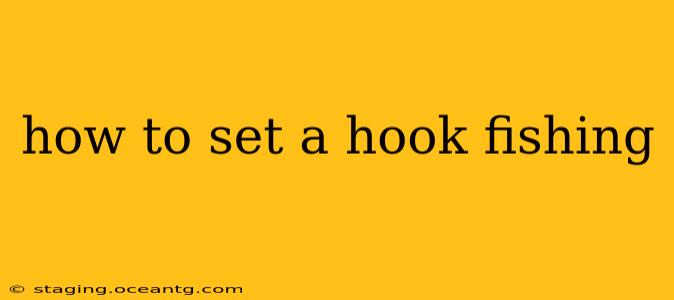Setting a hook properly is crucial for a successful fishing trip. It's the moment that transforms a nibble into a landed catch, and mastering this technique dramatically increases your chances of success. This guide will cover various aspects of setting the hook, from understanding the different types of strikes to the techniques used for different species and fishing styles.
What is Setting the Hook?
Setting the hook is the act of firmly embedding the hook point into the fish's mouth (or other target area depending on the fishing method) after it has taken the bait. This requires a swift and decisive action to prevent the fish from escaping.
Different Types of Strikes and How to React
Understanding the different ways a fish might take your bait is essential for properly setting the hook.
1. The Subtle Nibble:
A subtle nibble often requires patience. Don't immediately jerk; instead, wait for a more definitive bite or feel the fish's weight before setting the hook. A gentle lift of the rod tip is usually sufficient.
2. The Aggressive Strike:
An aggressive strike is easy to detect – a sudden, powerful tug on your line. In these cases, a swift and powerful upward sweep of your rod is needed to firmly set the hook.
3. The Follow:
Sometimes a fish will follow your lure or bait without immediately biting. Maintaining a slow, steady retrieve, accompanied by occasional pauses, can often entice a bite. Set the hook firmly upon feeling a tug or change in the line's tension.
Techniques for Setting the Hook
The optimal technique for setting the hook varies depending on the type of fishing, the species targeted, and the type of bait or lure used.
1. The Sweep Set:
This is a classic method, involving a smooth, upward sweep of the rod tip. It's effective for many types of fishing and is particularly useful when using live bait or lures that require a more delicate approach.
2. The Snap Set:
A snap set is a more aggressive technique, involving a quick and powerful jerk of the rod. This method is most effective when fishing with heavy tackle and targeting larger, more powerful fish.
3. The Thumb Set:
The thumb set is particularly useful when fishing with lighter tackle or using sensitive lures. Instead of relying on the rod to set the hook, you use your thumb to increase the tension on the line. This allows for more finesse and control.
Setting the Hook for Different Species
Different fish species have different biting styles, requiring adjustments to your hook-setting technique.
1. Setting the Hook for Bass:
Bass are known for their aggressive strikes, so a swift and decisive snap set is often effective.
2. Setting the Hook for Trout:
Trout often take the bait more gently. A softer sweep set is typically preferred to avoid tearing the delicate mouth.
3. Setting the Hook for Salmon:
Salmon can be powerful fighters. A firm, decisive sweep set, utilizing the power of your rod, is essential.
H3. What if I don't feel a bite?
Sometimes you might experience line movement without feeling a definite bite. This could indicate a snag, seaweed, or a very subtle bite. In such instances, a gentle lift of the rod might reveal the culprit. If it's a fish, the hook should set. If it's not, carefully retrieve your line to avoid further issues.
H3. How much force should I use when setting the hook?
The amount of force needed varies depending on several factors. Heavier tackle and larger fish require more force. However, excessive force risks tearing the fish's mouth or breaking the line. Strive for a firm, controlled set that is proportionate to the situation.
Conclusion
Setting the hook effectively is a skill honed through practice and experience. By understanding the nuances of different strikes, employing appropriate techniques, and adjusting your approach based on the fish species and fishing conditions, you significantly increase your chances of landing a successful catch. Remember to always practice responsible angling practices and respect the environment.
